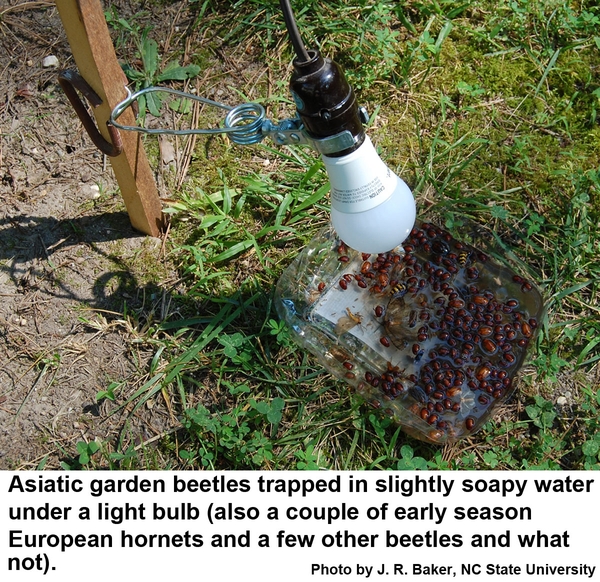Description and Biology
The Asiatic garden beetle, Maladera castanea, is much like the Japanese beetle in shape, biology and feeding habits although the Japanese beetle is slightly larger. Asiatic garden beetles are chestnut brown and may have a slight iridescent or velvety sheen. The abdomen protrudes slightly from the wing covers. Adults are emerge in early summer and feed on various kinds of ornamental and edible plants. They tend to feed close to the ground. Asiatic garden beetles are active throughout the growing season, but most occur in July and August. Adults emerge at night and fly actively whenever temperatures are above 70o F. Below 70o F, adults tend to crawl to plants or grasses to feed rather than fly. During the day, beetles hide in the soil around favored host plants. The Asiatic garden beetle seems to have overtaken and replaced the Japanese beetle in parts of the Eastern United States. One of the biggest differences between the Japanese beetle and the Asiatic garden beetle is that Japanese beetles fly and feed during the day and Asiatic garden beetles feed at night. Females lay eggs in clusters of three to 15 in a gelatinous material 1 to 2 inches under ground. Females produce about 60 eggs over several weeks. The oval eggs become spherical after absorbing water. About 10 days later, newly hatched grubs are about 1/16 inch long with light brown heads. Young larvae dig to the soil surface where they feed on roots and decomposing organic material. Mature larvae are 3/8 to 1/2 inch long if stretched out. As cool October temperatures arrive, grubs burrow down 8 to 17 inches to pass the winter. Grubs pupate the following late spring. White to tan pupae develop in the last larval skin and are about 5/16 to 3/8 inch long.
Host Plants
Adult Asiatic garden beetles feed at night in gardens and field crops, stripping foliage and petals, and leaving ragged damage (they do not skeletonize like Japanese beetles). Asiatic garden beetles feed on over 100 different plants, including leaves of boxelder, viburnum, peach, cherry, strawberry, carrot, beet, eggplant, pepper, turnip and flowers such as aster, chrysanthemum, dahlias, roses and goldenrod. Grubs can cause problems in ornamentals, blueberries, turf, gardens, sweet potatoes, soybeans, corn and other field crops. Grubs sometimes damage turf but seem to prefer roots of other plants. They often concentrate around weedy areas especially near orange hawkweed. Grubs are sometimes abundant near flower beds.
Residential Recommendations
The Asiatic garden beetle is attracted to lights. This suggests a possible means of control not useful for the Japanese beetle: light traps. Hang a light bulb above a pan of soapy water. Because this beetle tends to feed close to the ground, it would probably be a good idea to place the pan of soapy water on the ground and the light bulb about six inches above it. Asiatic garden beetles are not resistant to pesticides. Sevin and other insecticides labeled for residential landscapes should give adequate control.
References
- Common name: the Asiatic garden beetle, scientific name: Maladera castanea (Arrow 1913) (Insecta: Coleoptera: Scarabaeidae). Skelley, P. E. 2013. Featured Creatures, Entomology & Nematology, FDACS/DPI, EDIS, Publication Number: EENY-554.
- Asiatic garden beetle. Jeschke, M. 2019. Crop Focus, Pioneer Vol. 11 No. 15
- Extension Plant Pathology Publications and Factsheets
- Horticultural Science Publications
- North Carolina Agricultural Chemicals Manual
For assistance with a specific problem, contact your local Cooperative Extension Center
This Factsheet has not been peer reviewed.
Publication date: May 31, 2016
Reviewed/Revised: June 21, 2022
Recommendations for the use of agricultural chemicals are included in this publication as a convenience to the reader. The use of brand names and any mention or listing of commercial products or services in this publication does not imply endorsement by NC State University or N.C. A&T State University nor discrimination against similar products or services not mentioned. Individuals who use agricultural chemicals are responsible for ensuring that the intended use complies with current regulations and conforms to the product label. Be sure to obtain current information about usage regulations and examine a current product label before applying any chemical. For assistance, contact your local N.C. Cooperative Extension county center.
N.C. Cooperative Extension prohibits discrimination and harassment regardless of age, color, disability, family and marital status, gender identity, national origin, political beliefs, race, religion, sex (including pregnancy), sexual orientation and veteran status.







